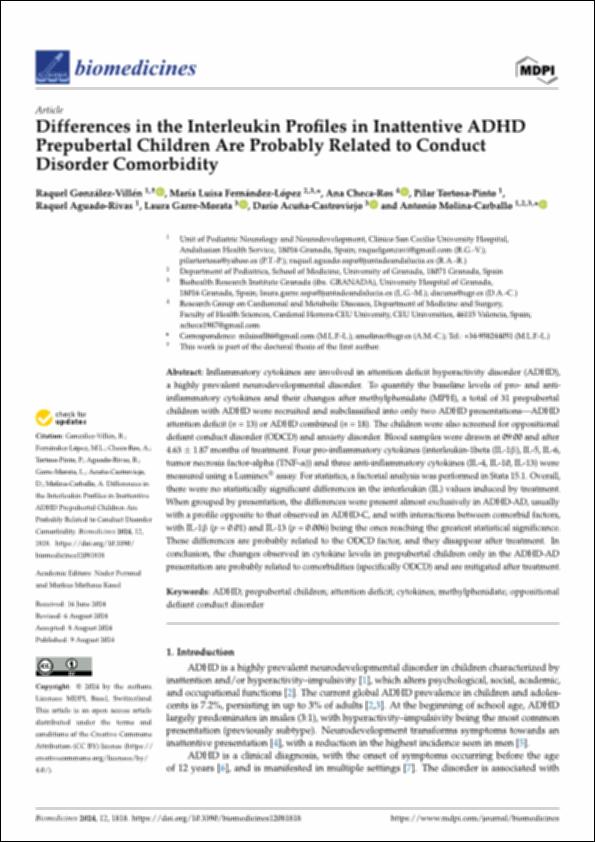Please use this identifier to cite or link to this item:
http://hdl.handle.net/10637/16191Differences in the interleukin profiles in inattentive ADHD prepubertal children are probably related to conduct disorder comorbidity
| Title: | Differences in the interleukin profiles in inattentive ADHD prepubertal children are probably related to conduct disorder comorbidity |
| Authors : | González Villén, Raquel Fernández López, María Luisa Checa Ros, Ana Tortosa Pinto, Pilar Aguado Rivas, Raquel Garre Morata, Laura Acuña Castroviejo, Dario Molina Carballo, Antonio |
| Keywords: | Trastorno por Déficit de Atención con Hiperactividad (TDAH); Attention Deficit Hyperactivity Disorder (ADHD); Niño; Children; Citoquinas; Cytokines |
| Publisher: | MDPI |
| Citation: | González-Villén, R., Fernández-López, M.L., Checa-Ros, A., Tortosa-Pinto, P., Aguado-Rivas, R., Garre-Morata, L., Acuña-Castroviejo, D. & Molina-Carballo, A. (2024). Differences in the interleukin profiles in inattentive ADHD prepubertal children are probably related to conduct disorder comorbidity. Biomedicines, vol. 12, i. 8 (09 aug.), art. 1818. DOI: https://doi.org/10.3390/biomedicines12081818 |
| Abstract: | Inflammatory cytokines are involved in attention deficit hyperactivity disorder (ADHD), a highly prevalent neurodevelopmental disorder. To quantify the baseline levels of pro- and anti-inflammatory cytokines and their changes after methylphenidate (MPH), a total of 31 prepubertal children with ADHD were recruited and subclassified into only two ADHD presentations—ADHD attention deficit (n = 13) or ADHD combined (n = 18). The children were also screened for oppositional defiant conduct disorder (ODCD) and anxiety disorder. Blood samples were drawn at 09:00 and after 4.63 ± 1.87 months of treatment. Four pro-inflammatory cytokines (interleukin-1beta (IL-1β), IL-5, IL-6, tumor necrosis factor-alpha (TNF-α)) and three anti-inflammatory cytokines (IL-4, IL-10, IL-13) were measured using a Luminex® assay. For statistics, a factorial analysis was performed in Stata 15.1. Overall, there were no statistically significant differences in the interleukin (IL) values induced by treatment. When grouped by presentation, the differences were present almost exclusively in ADHD-AD, usually with a profile opposite to that observed in ADHD-C, and with interactions between comorbid factors, with IL-1β (p = 0.01) and IL-13 (p = 0.006) being the ones reaching the greatest statistical significance. These differences are probably related to the ODCD factor, and they disappear after treatment. In conclusion, the changes observed in cytokine levels in prepubertal children only in the ADHD-AD presentation are probably related to comorbidities (specifically ODCD) and are mitigated after treatment. |
| Description: | Este artículo pertenece al número especial "Neurodevelopmental Disorders: From Pathophysiology to Novel Therapeutic Approaches—2nd Edition". |
| URI: | http://hdl.handle.net/10637/16191 |
| Rights : | http://creativecommons.org/licenses/by/4.0/deed.es Open Access |
| ISSN: | 2227-9059 (Electrónico) |
| Issue Date: | 9-Aug-2024 |
| Center : | Universidad Cardenal Herrera-CEU |
| Appears in Collections: | Dpto. Medicina y Cirugía |
Items in DSpace are protected by copyright, with all rights reserved, unless otherwise indicated.


